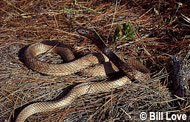Description:
Because of its usually feisty disposition, and resistance to handling, this is not a snake sought by a large number of hobbyists and collectors. It is not deliberately bred in captivity. Rather, the hatchlings that are occasionally offered are almost always the result of a clutch having been laid by a field-collected female and incubated. Hatchlings are from 13 to 16½ inches in length. A clutch may contain up to 2 dozen eggs. This is a big, speedy, sand-colored snake either with or without black on its head, neck and anterior body. Occasional examples are solid black. They are very alert and flighty, thus difficult to approach in the field. Most that are collected are found beneath ground-surface debris following a cool morning or while they are preparing for ecdysis. Utilizing a hunting method termed “periscoping†coachwhips depend largely on their acute vision to find prey and avoid enemies. In periscoping the head is held above the level of the vegetation through which the snake is slowly moving. If prey is seen it is grasped in a forthlong rush while enemies are avoided in a startlingly rapid departure. Coachwhips can be very difficult to acclimate to captivity. Most will bite readily, repeatedly and painfully. Although they have broad-based diet—small rodents, nestling birds, lizards, amphibians and even some insects—captives may steadfastly refuse to eat. Others may eat well, accepting mice ravenously. They frighten easily and may injure their noses by hitting the terrarium glass while striking or rubbing against roughened surfaces (such as screen tops) in an effort to escape. A hatchling or two may be temporarily housed in a 20 gallon capacity terrarium. A pair of adults should be housed in a 50 to 125 gallon capacity terrarium. This snake is more apt to abrade its nose in a small terrarium than if it is in a large tank. They can climb but are so nervous that they will probably not do so. Dry cypress, fir, aspen chips or bark shards are excellent choices for a substrate. A temperature of 78 degrees Fahrenheit at night and 85 degrees during the day is ideal for these snakes. Although they may not bask, a hot spot of 90 to 95 degrees is provided for several hours a day. A drinking bowl filled with fresh water should always be provided.
Habitat:
A generalist, the eastern coachwhip is at home in open mixed woodlands, sandy pine woodlands, pine-palmetto scrublands, as well as along creeks, marshes and swamplands.
Range:
This is an abundant snake of the southeastern Coastal Plain. A second population ranges southward from southern Missouri and Oklahoma to eastern Texas and Louisiana. A small population occurs in south central Kentucky.
Scientific Name: Masticophis flagellum flagellum
Species Group:
Family: Colubridae
Size: Adults routinely attain a very slender 6 to 7 foot length. Occasional examples may be 8½ feet long.
Level: intermediate
Weight:
Dangerous: No


